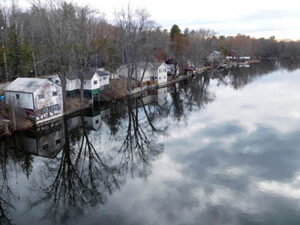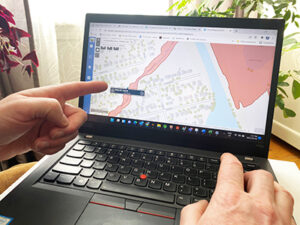Preparing for Flooding at the Cottage
One of Otonabee Conservation’s most important responsibilities is protecting people and property from flooding. Flooding at the cottage can ruin your vacation! Here are some tips to help you prepare so you can relax on the dock.

#1. Install a sump pump
Installing a sump pump can help mitigate flooding in your basement. Be sure to check your sump pump regularly to ensure it is functioning and in good repair.
#2. Check your appliances and equipment
Learn how to turn off appliances and shut off fuel supplies (oil, natural gas, propane) at your cottage before an emergency. Consult your electricity and fuel suppliers for instructions on how to safely shut down and take precautions to limit the risk of damage to your appliances and equipment to protect you and your property. Consider purchasing a portable generator and a portable pump for use in case of a flood emergency.
#3. Water Wise landscaping
Planting drought resistant, native plants can reduce your water use and filter runoff helping to protect your cottage, reduce erosion on shorelines, and improve water quality.
Did you know a rain garden can divert and filter up to 10,000 liters of water a year? A rain garden is created in the shape of a bowl to divert water away from buildings. Rain gardens also require very little maintenance so you can sit back and enjoy the cottage.
Programs and guidance for Water Wise gardens are available on the GreenUP website at greenup.on.ca. GreenUP also provides a variety of native plants available for purchase at the GreenUP Ecology Park in Peterborough.
#4. Search your address on new Floodplain Maps
Is your cottage located in or near the floodplain? Find out using Otonabee Conservation’s new interactive floodplain map by visiting otonabeeconservation.com/programs/floodplain-mapping .
The floodplain is identified using data and technical models to predict the path of floodwaters. It is important to remember that a floodplain map does not create a flooding hazard; it simply shows where the flooding hazard is. Knowing the extent of the floodplain is critical to planning for and reducing potential risks to your safety and damage to your property. 
#5. Stay informed!
Stay up to date and keep your cottage and family safe! Visit otonabeeconservation.com or follow us on social media to stay aware of flood messages. It’s also a good idea to check the weather forecast and stay up to date on information from your municipality and local news media before heading to the cottage.
Photo credits: 2 flooding photos Otonabee Conservation and the purple coneflower is Jessica Todd, GreenUP




